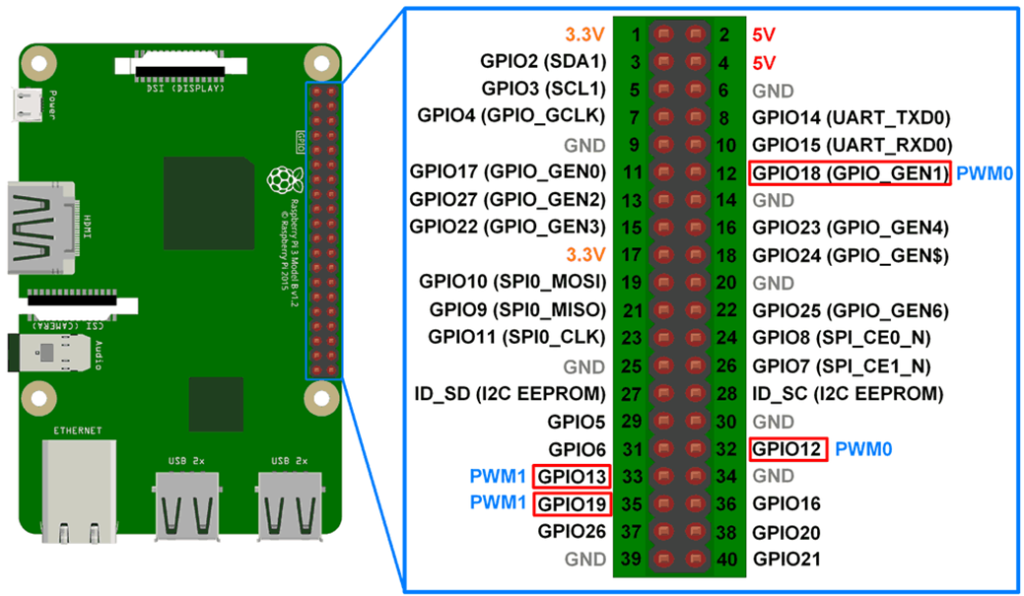Raspberry Pi 3 Model B V1.2

The Raspberry Pi is a credit-card-sized single-board computer developed in the UK by the Raspberry Pi Foundation with the intention of promoting the teaching of basic computer science in schools.
In some way, you can look at the Raspberry Pi as a normal computer, it has a processor, RAM, USB ports to plug a keyboard and a mouse, HDMI port to plug a TV or monitor, and you can even connect it to the internet.
You can do most things you do with a regular computer like web browsing, document editing, playing games, coding and much more.
The Raspberry Pi board has one special feature that normal computers don’t: General Purpose Input Output (GPIOs) Pins. These GPIOs let you to interact with the real world allowing you to build great electronics projects.
Features:
| Feature | Pi 3 Model B |
| Size | 85x56mm |
| Processor | 1.2GHz quad‑core ARMv8 |
| RAM | 1GB |
| USB Ports | 4 |
| GPIOs | 40 |
| Ethernet Port | Yes |
| HDMI | Full size HDMI |
| Storage | MicroSD |
| Wi-Fi | BCM43438 wireless LAN |
| Bluetooth | Bluetooth Low Energy (BLE) on board |
| Power-Source | MicroUSB |
Exploring the Raspberry Pi 3 Model B Board:

Below is a short summary of all these parts:
- USB ports: to connect a mouse, a keyboard or other peripherals. Total 4 USB ports
- Ethernet port: to connect to the internet using an Ethernet cable. Total 1 port
- Audio jack: to connect an audio device
- CSI connector: to connect a camera with a CSI ribbon
- HDMI connector: to connect a monitor or TV
- Processor: is the brain of the Raspberry Pi
- MicroSD card slot: to insert a microSD card to store your files and your operating system
- MicroUSB power input: to power up your Pi
- DSI connector: to connect DSI compatible displays
- Antenna: picks up wireless LAN and Bluetooth signals
- GPIOs (general purpose input output pins): connect devices to interact with the outside world like sensors and outputs like LEDs and motors
Raspberry Pi 3 Pin-out Diagram:

Power Supply:
The power supply requirements differ by Raspberry Pi model. All models require a 5.1V supply, but the current supplied generally increases according to model. All models up to the Raspberry Pi 3 require a microUSB power connector, whilst the Raspberry Pi 4 uses a USB-C connector.
Exactly how much current (mA) the Raspberry Pi requires is dependent on what you connect to it.
Raspberry Pi has developed their own power supplies for use with all models. For Raspberry Pi 0-3, we recommend 2.5A micro USB Supply. For Raspberry Pi 4, we recommend our 3A USB-C Supply.
The power requirements of the Raspberry Pi increase as you make use of the various interfaces on the Raspberry Pi. The GPIO pins can draw 50mA safely, distributed across all the pins; an individual GPIO pin can only safely draw 16mA. The HDMI port uses 50mA, the camera module requires 250mA, and keyboards and mice can take as little as 100mA or over 1000mA!
Power Supply Warnings:
On all models of Raspberry Pi since the Raspberry Pi B+ (2014) except the Zero range, there is low-voltage detection circuitry that will detect if the supply voltage drops below 4.63V (+/- 5%). This will result in a warning icon being displayed on all attached displays and an entry being added to the kernel log.
If you are seeing warnings, you should improve the power supply and/or cable, as low power can cause problems with corruption of SD cards, or erratic behaviour of the Pi itself; for example, unexplained crashes.
Voltages can drop for a variety of reasons, for example if the power supply itself is inadequate, the power supply cable is made of too thin wires, or you have plugged in high demand USB devices.




Thanks forma the initiative
Thank you!
Thank you so much sir for your support I have learned a lot from you. Believe me, you are the best
sir, I could not found the other Volg of ESP8266
Thank you so much!
Yes.. I am making everything streamlines line. Soon updating the previous projects blogs. All documents, step by step guides and al the working codes. Please stay tuned
Yes.. I am making everything streamlines line. Soon updating the previous projects blogs. All documents, step by step guides and al the working codes. Please stay tuned